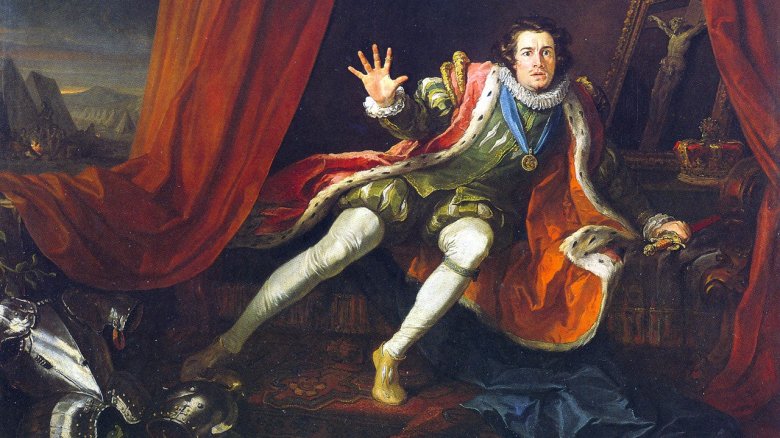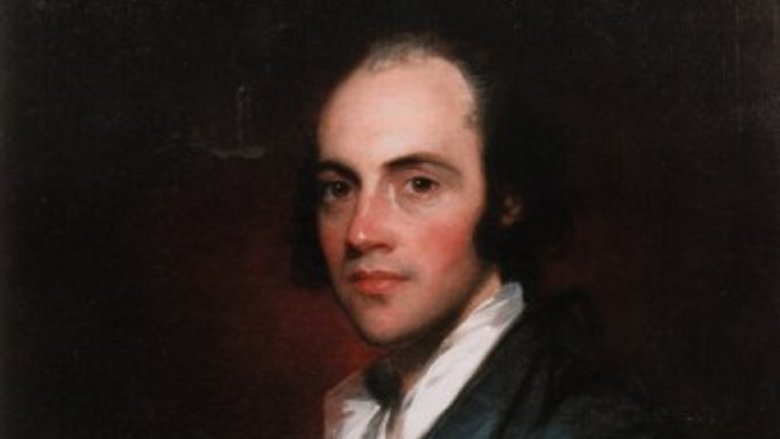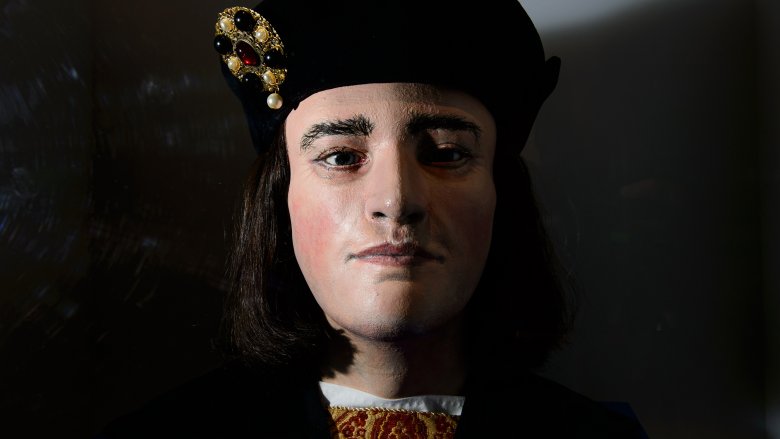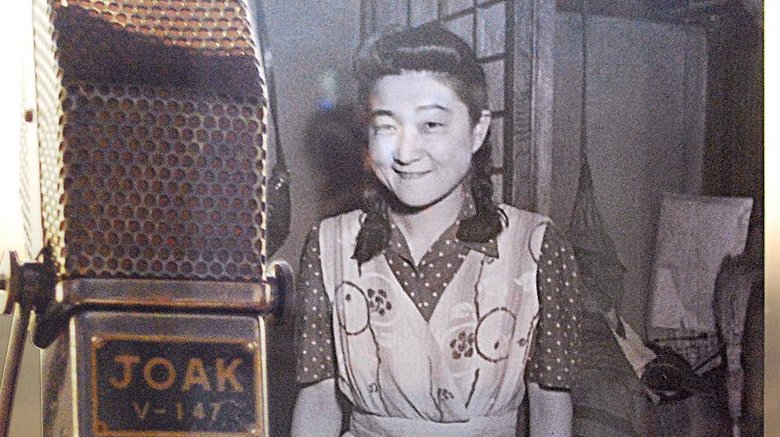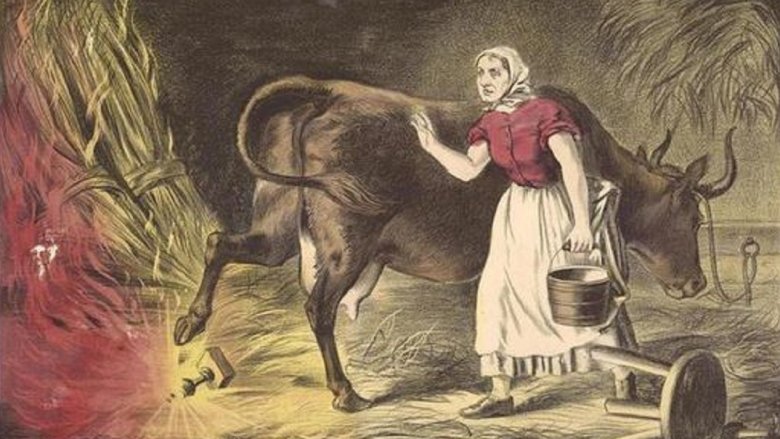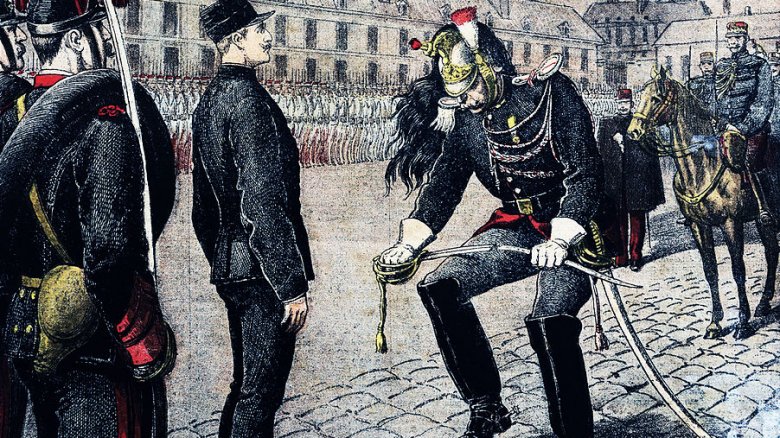Famous Villains Who Were Actually Innocent
Once you get labeled a villain, the world starts to see you in pitchfork vision. Your head sprouts invisible horns, your feet hide invisible hooves, and it behooves everyone to hate you. Over time, the misdeeds people think you did become the only deeds you've ever done, and if society doesn't efface you from memory, it remembers you as a face of evil. But from time to time, that face is completely made up, mascara masquerading as massacre. And what at first blush seemed like justified disdain makes history blush with shame. Monsters exist indeed and in misdeed, but it's also important to remember that sometimes the innocent get monstrously vilified.
Aaron Burr
Burr: the sound you make when it's really cold and you feel like killing a founding father. For many Americans, that pretty much sums up Aaron Burr, who fatally shot Alexander Hamilton in an 1804 duel. He also served as America's third vice president, but as Princeton Alumni Weekly writer Mark Bernstein observed, people prefer to focus on his other vices. Burr, in Bernstein's words, "has been portrayed as a conniver, a cynic, and a seducer. He has become an archetype, the 'bad' founder, an American Lucifer who fell from grace."
Frankly, America's Lucifer has been shown in a bad light. Thomas Jefferson spuriously asserted that Burr tried to steal the 1800 presidential election and later accused him of treason based on false information. Alexander Hamilton, America's $10 daddy, impugned Burr's character with truthless abandon, inciting their fateful showdown. Moreover, according to Time, by modern standards Burr should eclipse Hamilton as a hero, rather than the reverse.
Unlike Hamilton, Burr rejected economic elitism and xenophobia and championed the rights of indigents and immigrants. He also opposed slavery and called for an instant end to the institution in 1785. An avid advocate of gender equality, Burr heavily invested in his daughter's education and argued for women's rights. Plus, as Time opines, it's possible he didn't have his sights set on murder. People seldom died from duels back then, and the pistols –- which Hamilton picked –- were, in fact, trick pistols (via The Smithsonian). Burr aimed and shot in response and has been under fire ever since.
Richard III
Blind superficiality dictates that anyone who looks bad is bad –- the uglier the eviler. It's not just (oxy) morons who believe that, either. The brilliant William Shakespeare used his potent pen to poison the image of the oft-reviled Richard III. Many of you may recognize Richard as the hideous hunchbacked king who made much ado about horses in the aptly titled Richard III. He was also maligned for murdering two princes trapped in a tower, murdering Henry VI and his son, murdering his own brother, murdering some more people, and presumably beating a dead murder-horse.
Not to knock Shakespeare, but in this instance he was basically an Iago parroting other people's slurs. As The Telegraph explained, Richard III suffered the slings and arrows of outrageous Tudor libel. He was the last of the Plantagenet line and once the Tudors took over, they tarnished his memory with ignominious images and aspersions. Shakespeare simply followed suit.
In reality, Richard wasn't some deranged, deformed despot. His suffered from scoliosis, reports the BBC. And according to the University of Leicester, he was a thoughtful, well-regarded ruler who implemented pivotal legal forms. Richard's the reason English law presumes possible lawbreakers innocent until proven guilty. He also updated the jury system and created England's first legal aid service. The Telegraph further noted that Richard didn't cause most of the deaths attributed to him. It is possible he killed the princes in the tower, but the reformed jury's still out on that one.
Patient Zero
Mating is always a game of genital roulette. But in 1980s America, the only outcome people seemed to fear was AIDS. Initially touted as a "gay" disease, the virus quickly outed itself as an indiscriminate killer whose only sexual preference was sex itself. People pined for someone to blame. In the late '80s, they zeroed in on Gaetan Dugas, the infamous "Patient Zero."
Per NPR, Dugas was a Canadian flight attendant with a hearty carnal appetite. During his dalliances in the '70s, he contracted HIV and most likely infected others. Of course, people knew next to nothing about HIV and AIDS or how they spread. Dugas helped illuminate the issue by partaking in a study on homosexual men with HIV. In the resulting paper, he was anonymously labeled Patient O (the letter), as in "Oh no, people are going to horribly misconstrue this."
"Patient O" became "Patient Zero" in Randy Shilts' 1987 work And the Band Played On, in which Shilts baselessly pinned the bulk of America's (and possibly North America's) AIDS epidemic on Dugas. According to The LA Times, the book painted Patient Zero as "a vain and arrogant playboy who ignored doctors' orders to stop having sex to keep his infection from spreading." The media bought that steaming pile of Shilts, branding Dugas "the man who gave us AIDS." In reality, AIDS had existed in the U.S. years before Dugas could have spread it. Even so, the lie plays on.
Tokyo Rose
"Tokyo Rose" is an elegant way to describe barbed human beings. According to the History Channel, it was the nickname American troops gave Japan's female radio propagandists during World War II. In a series of English-language broadcasts, these women hurled threats and venomous invective at Allied forces, even insinuating that the soldiers' wives were polishing other men's missiles.
However, one of those sentient thorns proved particularly un-prickly, a hokey jokester who issued tongue-in-cheek insults. That Tokyo Rose was named Iva Toguri. A California native and college-trained zoologist, Toguri had gotten stranded in Japan while visiting an ailing aunt. She later got roped into hosting a radio show because of her oddly mannish voice. To be clear, the Japanese weren't weaponizing oral androgyny. The decision to hire Toguri was an act of sabotage by Major Charles Cousens, a captive Aussie officer tasked with airing Japan's propaganda. Determined not to aid the enemy, Cousens subverted anti-Allied broadcasts through semi-subtle mockery. Toguri's intensely unsexy voice and intentionally unserious tone became crucial aspects of that endeavor.
After the war, U.S. officials initially cleared Toguri of wrongdoing. Unfortunately, the rabidly anti-Japanese public denounced her as a traitor. Since justice is apparently a popularity contest, the government tried Toguri for treason in 1948, and a parade of false witnesses sealed her fate. She spent six years in prison and lost her citizenship. During the 1970s, Americans regretted ruining Toguri's life and successfully petitioned for a presidential pardon because fairness is frighteningly fickle.
Pearl Harbor's scapegoats
On December, 7, 1941, Japanese fighter pilots descended on U.S. servicemen stationed in Pearl Harbor, Hawaii. As the History Channel detailed, increasingly undiplomatic exchanges between America and Japan had reached an acrimonious impasse. Determined to stake a claim on China without U.S. intervention, Japan resorted to preemptive brutality. Like marauding mechanical storm clouds, hundreds of planes unleashed a lethal hail of bombs and bullets on soldiers, ships, and shipmen. The ambush left 2,403 Americans dead and 1,178 wounded.
The U.S. had taken a staggering sucker punch, and in the ensuing months, the government tasked the Robertson Commission with discovering why. Per CBS affiliate WUSA 9, the commission held two men especially responsible: Admiral Husband E. Kimmel (shown testifying above) and Lieutenant General Walter Short. The men had supposedly received intel on a possible Japanese assault, only to greet the news with statuesque inaction. The commanders were commanded to retire.
In the aftermath, seething civilians refused to hold back their bile. Kimmel got flooded with threats hate mail. In one instance, someone sent him a gun and instructions to shoot himself. An ex-judge also encouraged suicide after asserting in no uncertain terms that Kimmel's life had no value. But what these pre-internet trolls failed to realize was that the government had erred in its assessment. The New York Times revealed that reports of an impending attack never reached Kimmel and Short. In 1999, the U.S. Senate contritely pardoned the pair. Sadly, they weren't alive to see it.
Catherine O'Leary
In 1871, Chicago became an ashen graveyard full of baked and burnt bodies. A prolonged period of feverishly high temperatures had turned the city into kindling, and on a fateful night in October a vast legion of flames laid siege. Per Smithsonian Magazine, the blaze resulted in roughly 300 fatalities and displaced 100,000 residents. Over 2,000 acres of the city had been decimated. Traumatized Chicagoans wanted answers.
Local media outlets eagerly obliged, foisting the blame onto an Irish immigrant named Catherine O'Leary. O'Leary had the dual misfortune of living at the home where the fire started and being a foreigner at a time of mounting xenophobia. She was a tragically convenient target, and reporters pulled no punches. The Chicago Times matter-of-factly stated that O'Leary intentionally started the fire in her barn, citing abject wretchedness and a sour disposition as the reasons. Others claimed O'Leary's cow had kicked over a lantern while she was milking it, never offering an explanation for why she wouldn't have sought help.
O'Leary vehemently denied the reports, explaining that she was asleep when the blaze began. But her protestations fell on unhearing ears, and people continually harassed her. Even P.T. Barnum purportedly paid a visit to recruit her for his circus. (She declined.) O'Leary died a dejected, utterly defeated woman. According to the Chicago History Museum, reporter Michael Ahern later publicly patted himself on the back for slandering O'Leary. The story of her starting the blaze was a brazen lie.
Alfred Dreyfus
People normally associate French intellectualism with hoity-toity, baguette-smoking know-it-alls like Jean-Paul Sartre, but that's not all there is to know about it. As the New York Times elaborated, France's tradition of snooty-booty thinkers originated with a late 19th-century court case that polarized the populace, incited duels, and reeked of acrid antisemitism. At the heart of this societal schism was French Army officer Alfred Dreyfus.
In 1894, the French military uncovered evidence that Dreyfus had conspired with German forces during the Franco-Prussian War, contributing to France's eventual defeat. The blame actually lay elsewhere, but according to the History Channel, Major Hubert Henry had concocted a letter that fingered Dreyfus as the culprit. Even with this manufactured proof, the allegation proved largely untenable. However, Dreyfus was Jewish, which made him guilty in the eyes of many officers and the public at large.
Dreyfus was unceremoniously court-martialed, deprived of his rank, and shipped off to Devil's Island. As the truth surfaced, members of the literati (the soon-to-be-dubbed "intellectuals") flocked to Dreyfus's defense, noting the train-sized holes in the prosecution's case. Others continued castigating Dreyfus and Jews in general, sometimes lashing out violently. The military, meanwhile, refused to budge, even when the true traitor was discovered. Instead, it stubbornly absolved the culprit and convicted Dreyfus a second time. The French government later overturned this farcical decision, granting Dreyfus his freedom. In response to the often-bigoted mayhem that occurred, France's government established a separation of church and state.
Frank Walus
In 1977, the world regarded Chicagoan Frank Walus as Hitler Lite. The U.S. government had implicated him in war crimes, acts so awful that not even nations engaged in competitive killing can commit them. Per the Washington Post, Walus spent all the money he had plus a bunch of money he didn't have trying to defend himself. But the evidence seemed insurmountable. In court, 11 Holocaust survivors attested to seeing Walus murder defenseless Jews in Nazi-occupied Poland. Witnesses journeyed all the way from Israel to condemn the alleged butcher on justice's chopping block.
In 1978, Walus was found guilty. Serious crimes had doubtlessly transpired, but Walus was the victim, not the perpetrator. The charges leveled against him were vicious fictions, the spiteful contrivances of a vindictive ex-tenant named Michael Alper. Alper was a Polish immigrant whose parents perished in the Holocaust. In 1971, he moved in with Walus but got tossed out over apparent dishonesty. Alpers avenged his eviction by approaching a Jewish organization with chilling tales of Walus' sordid Nazi past.
Alper's incriminating claims weren't remotely credible. Walus couldn't have murdered Jews in World War II Poland because he was in Germany at the time. And as a short, conspicuously non-Aryan male, he would have been barred from joining the SS. But once Walus was publicly prosecuted, people lined up to persecute him, fabricating facts to ensure a conviction. Walus eventually proved his innocence, but his reputation proved unsalvageable.
The Guildford Four
To call "The Troubles" troubling would be reductively redundant. When England annexed part of Ireland, it ignited a powder keg of political, religious, and social strife. Irate dissidents like the IRA wanted to expel the English, and they frequently expressed themselves through explosions. In fact, for nearly a quarter-century, Belfast boasted "the most bombed hotel in the world," according to The Irish Times. But one of the IRA's most incendiary attacks took place at a pub in Guildford, England, in 1974. As the New York Times detailed, five people died, more than 50 sustained injuries, and a group of unlucky chums got charged.
Known as the Guildford Four, the star-crossed quartet consisted of Carole Richardson, her boyfriend Patrick Armstrong, Paul Hill, and Gerry Conlon (shown above). The first two were freewheeling hippies and the latter two were former schoolmates who liked to drink. Police had tortured Hill into confessing. Under severe duress, he falsely copped to the Guildford attack and a London pub bombing and further pointed the finger at his friends.
British authorities arrested the rest of the Guildford Four. For bad measure, they also rounded up Gerry Conlon's father, aunt, and five other people (dubbed the Maguire Seven). All did time based on bogus evidence while the police were hailed as heroes. Per The Telegraph, the Guildford Four and Maguire Seven were vindicated and released years later, but in one case freedom came too late. Conlon's falsely imprisoned father died behind bars.
The Central Park Five
Self-certainty transforms fiction into unwavering conviction. And during the late 1980s and early '90s, the falsely held convictions of crime-wave-weary New Yorkers turned five innocent teenagers into the poster children for societal decay. As New York Magazine described, back then the Big Apple festered with drugs, violence, and racially tinged economic tensions. These stressful elements convulsively collided in 1989 with the barbaric beating and rape of a woman jogging in Central Park.
According to the New York Times, the victim, Trisha Meili, had been so savagely assaulted that she couldn't recall the attack. Police charged five youths, aged 14 to 16. Branded the Central Park Five, these putative felons drew the unmitigated ire of disgusted denizens. Even Donald Trump weighed in on the matter, indirectly calling for a swift, severe punishment.
Opinions fractured along socioeconomic lines. Meili was a white investment banker. The Central Park Five were all black or Hispanic youths. Some saw the suspects as an urban scourge. Others felt they'd been wrongly vilified. But before the truth could unveil itself, police rewrote reality by extracting fake confessions from the teens. Despite flawed physical evidence and evident flaws in their confessions, all five got convicted. Their prison stints ranged from 7 to 13 years.
Eventually, DNA evidence exposed the real malefactor, a serial rapist and murderer who had acted alone. By then, some of the teens had spent almost half their lives in captivity. As recompense, the city approved a $40 million settlement.
Dan and Fran Keller
It might sound silly now, but the game Dungeons & Dragons used to scare the bejesus out of Christians. It wasn't the dungeons or dragons per se that bothered them, but the distinct lack of Jesus. In fairness, Jesus and Dragons sounds amazing. But rather than bringing that joy to the world, the fearful faithful denounced Dungeons & Dragons and any person, place, or thing they deemed vaguely satanic. As the Washington Post recollected, this so-called "satanic panic" spanned much of the 1980s and '90s and sparked a spate of highly publicized arrests.
Literally thousands of children, many of them coached by therapists, falsely accused adults of unconscionable cruelties and perversions likened to devil worship. Among these supposed sinners were Texas daycare managers Fran and Dan Keller. Children at their facility claimed that the Kellers perpetrated an ungodly number of evils, including child murder, molestation, resurrecting the dead, chainsawing a dog's privates, and (impressively) "using Satan's arm as a paintbrush." Circumstantial evidence and shoddy investigative work led to a sexual assault conviction in 1992. Both Kellers received 48-year prison sentences.
It took more than two decades for a court to overturn the unjust verdict. In the meantime, the couple suffered tremendously. Fran Keller recounted having boiling water lobbed at her by incensed inmates who didn't take kindly to child abusers. The Kellers won their freedom in 2013 and were awarded $3.4 million. Finally, they can play as much Dungeons and Dragons as they want.
